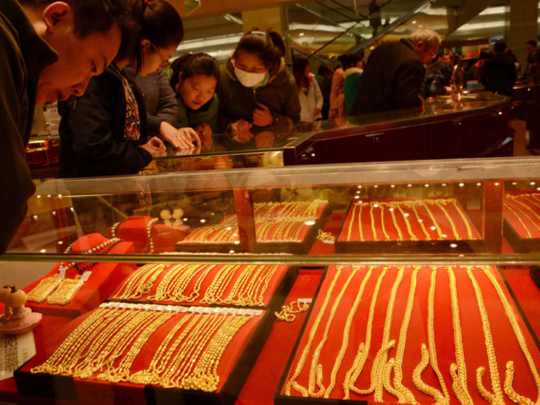
London: Ultra-calm trading conditions in gold are becoming self-perpetuating as a persistent lack of volatility frustrates investors seeking a return, pushing them further away from a market that analysts say could be becalmed for years.
Gold, which saw a dramatic reversal last year after a 12-year bull run took prices to record highs in 2011, has seen the spread between its daily price highs and lows narrow to just $15 (Dh55) an ounce this year on average, from nearly $25 in 2013.
Implied volatility, an estimation of an asset’s future volatility, has dropped in gold to around 12 per cent this month from an average of 19 per cent in August last year, and from highs of nearly 60 per cent in mid-2008.
With the dollar strengthening, equities showing a better return, and signs of inflation still notably absent from most developed economies, the metal has run out of reasons to rise.
“We are pretty unexcited by the outlook of gold,” Charles Morris, head of absolute return at HSBC Global Asset Management, said. “It could stay in this range for another five years.
“If inflation is under control for a long period of time, then gold will be under control for a long period of time, and because you don’t get a yield, it is a waste of money to have a large position in gold.” Gold is not the only market to be losing momentum.
Volatility in the global foreign exchange market approached historic lows in July, while average daily volumes dropped by almost 14 per cent, data from FX settlement system CLS showed.
“What the central banks have done to provide liquidity has pushed down volatility in the commodity market, and interest rates market, and indeed equities,” Credit Suisse analyst Tom Kendall said. “They all feed through to every part of the traded economy, so it is a problem for FX traders, it is a problem for interest rates traders, it’s a problem across everything.” As an asset in its own right, gold does not lack price drivers at the moment. The problem is, they are working against each other.
Inflationary effects
Federal Reserve policy is slowly normalising after years of ultra-loose conditions, which had fed into rising gold prices.
The US central bank has signalled that it is ready to start thinking about raising interest rates, probably next year.
That should be pushing prices lower, as should a rise in the dollar index this year. But working against that is uncertainty over the long-term inflationary effects of the monetary stimulus measures that followed the 2008 financial crisis.
Gold has also taken support from outbreaks of violence in Ukraine and the Middle East, which some fear may destabilise a fledgling recovery in the European Union and push up oil prices.
The fact that this unrest has not done more to push prices is adding to investors’ caution over gold.
“There has been very little and short-lived correlation between the Middle East problems, Russia and Ukraine with gold itself,” Adam Laird, investment manager at Hargreaves Lansdown, said.
“There is a lot of concern among smaller investors that the market has not been able to react to wider political events.”
Store of value
Not all buyers are seeking price volatility. Those who buy metal as a store of value, for instance, prefer a stable market.
This has particularly been true in India, historically the world’s biggest gold consumer, where buying dried up during the violent price moves that followed the collapse of Lehman Brothers.
But supply to Indian consumers has been constrained by restrictions on gold imports as the government tries to get its current account deficit under control, meaning its response to a more appealing price environment has been limited.
Meanwhile buyers in China, which has recently overtaken India as the world’s number one gold consumer, appear much less happy with price stability.
Consumer demand is not in any event going to lead to a repeat of gold’s scorching price rise of the last decade. The doubling in gold prices in the three years to September 2011 was overwhelmingly due to investment flows, as funds piled into the metal as a haven from financial market risk.
What would turn gold around would be a significant rise in inflation, which few economists see happening any time soon.
Until another clear driver emerges, investors prefer to stay on the sidelines.
“Essentially, you have plenty of supply, [and] demand is likely to fall because of low volatility, rising interest rates and a strong dollar,” HSBC’s Morris said. “You put all this together and you think: ‘why are people going to come running’?”












